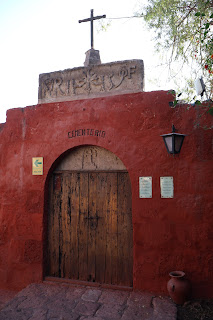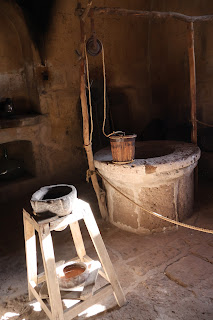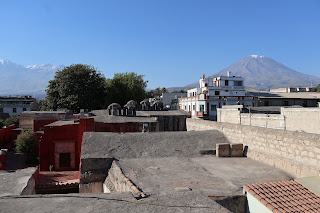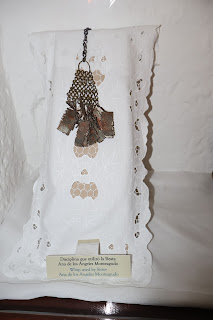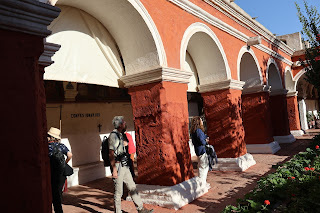The Monastery of Santa Catalina de Siena is a large monastery of the Dominican
Second Order, located in Arequipa, Peru.
This citadel was located in the south of Peru in the city of Arequipa, founded
on September 10, 1579 and located in an area that stands out for its natural
beauty, welcoming climate and that has a great material with which the
architecture of this city is built and continues to be built, the tuff.
The citadel occupies an area of 20,000 square meters, "it constitutes a true
and small city, characterized by its multitude of streets, somewhat tortuous,
broken and narrow." And is completely isolated from the city, despite being
located in the heart of it. A great and solid wall of 4 meters of height
isolated the life of the women who inhabited the monastery.
|
Entering the monastery of Santa Catalina de Siena
The entrance portal is adorned with a relief of St. Catherine of Siena,
under whose patronage the monastery was founded.
-
It is carved into the solid tuff wall that borders the entire block.
-
The sober simplicity of shapes and color of this cover contrasts with
the cheerful color that the visitor will find in the interior
environments.
|
|
Courtyard del Silencio
It was the place where the nuns gathered to pray the Holy Rosary and
read the Bible in complete silence.
|
|
Locutory
The locutory, speak room, or parlor is the place where nuns can receive
visitors or talk to people outside the monastery.
-
It’s usually divided by a grille or lattice that prevents physical
contact between the religious and visitors.
-
Nuns deliver and receive objects to and from people outside the
monastery or convent using a turnstile, in the last photo, a
small revolving cupboard that communicates the interior of the
monastery with the exterior while conserving their separation.
|
|
Novice cloister
Marked by a rubber tree at its entrance, this was an area where nuns
were required to swear a vow of silence and dedicate their lives to
prayer and work.
-
Nuns served as novices for 4 years, whereby their families had to pay
a dowry of 100 gold coins per year.
-
At the end of the 4 years, the novice could choose between entering
into a full life of service or to leave the convent (bringing shame
upon her family).
|
|
A nun's cell
Due to the constant earthquakes that affected the monastery, the
families of the nuns chose to build unique and private cells for each
one of them.
-
What caused there to be ordered sectors and in the absence of a plan
others with a notorious disorder.
-
For almost two centuries during the colony, the cloisters and cells of
the monastery have undergone various modifications, additions and new
constructions that have made Santa Catalina a counter on a human scale
of Arequipa's colonial architecture.
|
|
Chapel
Small chapel in the novices' cloister.
|
|
Orange Cloister
It dates from 1738. It owes its name to the presence of orange trees.
-
The three crosses located in the middle of the cloister are part of a
tradition of the Santa Catalina Monastery, where the nuns represent
the Passion of Christ every Good Friday.
- This was where nuns went after they graduated from novice.
|
|
A nun's cell
A nun's cell in the Orange cloister.
|
|
Profundis Room
Found in this area is the Profundis Room. A room where deceased nuns are
mourned and their portraits line the walls.
|
|
Cell of nun M. Dolores Llamosas
|
|
Zurbaran Room
Saint Michael the Archangel. 17th c.
-
Painting by an anonymous author influenced by Zurbaran and the Seville
school.
- Colonial baroque. Oil.
|
|
Córdova Street
As we leave the orange cloister, down Córdova street, cells that served
as living quarters for the nuns can be found.
|
|
Painting of Rose of Lima
Rose of Lima, TOSD (born Isabel Flores de Oliva; 20 April 1586 – 24
August 1617) was a member of the Third Order of Saint Dominic in Lima,
Peru, who became known for both her life of severe penance and her care
of the poverty stricken of the city through her own private efforts.
-
Rose of Lima was born to a noble family and is the patron saint of
embroidery, gardening and cultivation of blooming flowers.
-
A lay member of the Dominican Order, she was declared a saint by the
Catholic Church, being the first person born in the Americas to be
canonized as such.
-
See more at
Rose of Lima - Wikipedia.
|
|
The Rules of the Dominican Order
The first convent to be founded by the renowned Saint Dominic de Guzman
was that of Prouille, France, in 1210, for a group of converted heretics
and religious ladies. The saint entreated the nuns to pray and meditate
in order to provide spiritual aid to the Order of Preachers (First
Order) and the active-life lay brothers (Third Order).
-
The Rule of Saint Augustine forms the basis of Dominican legislation,
which covers all aspects of religious life, from charity or keeping
silence, to clothing and deportment. According to the Rule, the nuns’
daily duties include prayer, the holy service (for the black-veiled
nouns), a half hour of meditation in the morning and the afternoon,
saying the Rosary, and performing manual chores.
The Rule and Organization in the Convent
At the founding of the convent, it was written that a prospective nun
‘should be Spanish’, should provide a dowry and bring her trousseau. By
and by, these and other rules, such as those which allowed the nuns to
receive Holy Communion only ‘fifteen times a year’ or to 'wash and cut
the hair seven times a year’, have been modified in later reforms of
convent rules.
-
The life of the convent is directed by the Prioress, who presides at
the Council or governing body and at the Chapter of Offenses (a weekly
meeting for the nuns’ confession, reflexion and repentance).
-
The Prioress is elected every three years at the Chapter of the
Convent, which is attended by the black-veiled nuns. She should be
more than thirty-five years of age. She is aided in her work by the
Subprioress, the Vicaria (a kind of secretary or personal
assistant) and other nuns with important official functions: the
Governess of the Novices, the Secretary of the Council, the
Procuratrix (in charge of material aspects), the Trustees (who look
after the finances) and the Sacristana (responsible for the
church and the sacristy). In addition there are the Nurse, the
Doorkeeper, the Archivist, the Warden and the Torneras (who
look after the torno, a kind of revolving dumbwaiter).
-
In order for a prospective nun to be accepted, and take her vows in
the convent, the Council, the Chapter of the Convent, and the Prioress
must give their consent; the Bishop must also be informed. The
novitiate lasts for one year, and may be extended a further six
months. The taking of vows, which are of poverty, chastity and
obedience, converts the novice into a nun. Nuns may be black-veiled,
or de coro; or white-veiled, or obedience. The latter are at
the service of the Community and do not have the right to vote.
|
|
Clock of Meditation
Embroidered using silk thread, sequins, and beads, this Sacred Heart of
Jesus enclosed within the sphere of a twenty-four hour clock — a
Meditation Clock or Clock of the Passion, offering an overview of the
most outstanding episodes from the final 24 hours in Jesus’ life, each
summarized in poetic quatrains.
-
This adorned piece of craftwork — which calls upon the faithful to
remember the Passion throughout the day — was made by Sor Manuela de
los Angeles Gutiérrez, who took her vows as a black-veiled nun in
1859, at the age of 24, and later served as the convent’s prioress
(1894-1898). Manual labor is a daily obligation according to the Rule
of the Priestly Orders of Saint Dominic (the order to which this
convent belongs).
-
Apparently, even the verses here were the creation of Mother
Gutiérrez, as suggested by the phrase embroidered at the bottom:
“Devotion of Sister M. de los A. G.”
-
This Meditation Clock is distinctive in that the pivotal moments of
the Passion are arranged symbolically and correlated with the local
time when the events are thought to have occurred. At the top of the
circle, for example, when it was 3 p.m. in Jerusalem (the time at
which Jesus is considered to have died), the clock reads 8 a.m. in
Arequipa. In other words, the craftswoman took into account the
seven-hour time difference between Arequipa and Jerusalem, placing the
key event at the top of the clock and numbering the rest of the hours
accordingly.
|
|
St. Catherine of Siena
This small cell features the picture of St. Catherine of Siena.
-
This monastery was given appellation to this tertiary Italian
Dominican saint of the XIV century, who made the See of the Papacy
return to Rome.
-
She was one of the three doctors of the Church, although she never
received formal academic training.
|
|
Cell of nun M. Dominga Somocursio
|
|
Cell of nun M. Cipriana Centeno
|
|
Laundry
It was built in 1770, when Arequipa was supplied with water through
ditches.
-
In it we find 20 half urns, which are large clay containers, used in
the past to store grains, corn or wine, which served as trays.
-
The water ran through a central channel, which was diverted to each
jar by placing a stone and at the bottom of the tray they put a plug,
which after washing was removed and the water ran towards the
underground channel that carried the waste to the river.
|
|
Cell of nun M. Manuela Ballón
|
|
Kitchen
This kitchen draws a lot of attention for the particularity of its
environment that takes us back centuries.
-
Some experts believe that its high domed ceiling was due to the fact
that it was or was going to be used as a chapel.
-
The kitchen worked with coal, firewood and other fuels, that is why
all the walls are blackened and the utensils that can be seen in it
are original from that time.
|
|
Climbing onto the roof of the monastery
|
|
Panorama of the view from the roof
|
|
Entrance to the cell of M. Sor Ana de los Angeles Monteagudo.
|
|
Cell and Chapel of the Blessed Sister Ana de los Ángeles
Monteagudo.
The cell where the Blessed Sister Ana de los Ángeles Monteagudo lived
her saintly existence has been made into a chapel, a place for prayer
and pilgrimage for dozens of worshippers. There are relics and objects
used by Arequipa's Blessed Sister.
-
“In her, we admire especially the exemplary Christian, the
contemplative, Dominican nun of the famous monastery of Santa
Catalina, monument of art and piety for which Arequipa feels rightly
proud. Today the Church in Arequipa and all over Peru wants to worship
God in a special way for the benefits of a humble nun. It is Sor Ana
de los Ángeles, the blessed of the Church”. His Holiness Pope John
Paul II.
|
|
Painting representing Sister Ana de los Angeles Monteagudo
Ana Monteagudo Ponce de Leon, OP (26 July 1602 – 10 January 1686), also
known as Ana (or Ann) of the Angels Monteagudo, was a Peruvian Catholic
nun from the Dominicans.
-
Monteagudo studied under nuns in her childhood and decided to become
one following a vision she had of Catherine of Siena showing her the
Dominican habit.
-
Her parents made the effort to dissuade her from this though she
continued to pursue that path until she was inducted as a member of
the Dominicans.
-
She became noted for her holiness and held leadership positions due to
her wisdom and the esteem that others had for her.
-
Pope John Paul II beatified Monteagudo in 1985 upon his apostolic trip
to Peru.
-
See more at
Ana of the Angels Monteagudo - Wikipedia.
|
|
Scapular (top), chalice, thurible and incense (middle) and relics
(bottom).
- Top: Scapular of Sister Ana de los Ángeles Monteagudo.
-
Middle: Chalice, thurible and incense used by His Holiness Pope John
Paul II.
- Bottom: Relics of the Bishops.
|
|
Holy Christ (center) and Saint Thomas of Villanueva (right).
At the feet of this image, Sister Ana de los Angeles placed the key to
the monastery and the Holy Christ ordered her to accept the office of
Mother Prioress.
-
Saint Thomas of Villanueva - Sister Ana had a lot of devotion and
affection for him, she was aware of his kinship with this Holy Bishop.
|
|
Bed of Sister Ana de los Ángeles
|
|
Cilice used by Sister Ana de los Ángeles Monteagudo
|
|
Whip used by Sister Ana de los Ángeles Monteagudo
|
|
Major Cloister
Built between 1715 and 1723, it is the largest cloister in the
Monastery.
-
On the left side there are 5 confessionals that had the required
privacy.
-
Around it are located paintings intended for the preparation, teaching
and catechization of nuns, as in the other two cloisters. There are a
total of 32 colonial paintings, 23 refer to the life of Mary and 9 to
the public life of Jesus.
|
|
Entrance to the church's high choir
|
|
Entrance to the church's low choir
|
|
Art gallery of the monastery
Approximately 400 colonial art pieces.
-
The main works are exhibited in a majestic setting: two immense rooms
with high vaults, arranged in a cross, in which the stucco has been
removed, leaving the walls in ashlar.
-
To the side another smaller vault completes the architectural unit
dedicated to the museum.
|
|
Figures to be used during the Holy Week procession
A Holy Week procession is a public ritual march of clergy and penitents
which takes place during Holy Week in Christian countries, especially
those with a Catholic culture.
-
Various images of the saints, especially the Virgin Mary, and most
importantly the image of the crucified Christ are carried aloft by
foot on shoulder-borne pasos as an act of penance; acts of
mortification are carried out; traditional Christian hymns and chants
are sung (except during the silent processions of Good Friday).
-
Crosses, and biers holding Catholic holy images surrounded with
flowers and offerings of candles, are carried usually from one parish
church to another led by the clergy, monastic orders, or heads of the
penitential orders.
-
See more at
Holy Week procession - Wikipedia.
|
See also
Source
Location
Viewpoint and Church of Yanahuara
Tio Dario Restaurant
Basilica Cathedral
Salinas y Aguada Blanca National Reserve
















































